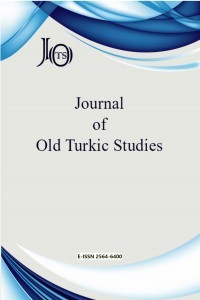Tarihî Çeşmeler ve Niğde Tarihî Kent Merkezi Çeşmeleri Üzerine Bir Araştırma
historical fountains, historical cities, Niğde fountains, Niğde historical city center
A Research on Historical Fountains and Nigde Historical City Center Fountains
___
- Açıkgöz, F. et al. (2016). Niğde Kültür Envanteri I. Niğde: Salmat Basın Yayıncılık Ambalaj Sanayi ve Ticaret Ltd. Şti.
- Afonso MJ. et al. (2016). Environmental Groundwater Vulnerability Assessment in Urban Water Mines (Porto, NW Portugal). Water, 8(499), 1-23.
- Akşit, A. (2004). Niğde’nin Selçuklular Devrindeki Nüfusuna Dair. Tarih Araştırmaları Dergisi, 23(36), 1-5.
- Angelakis, A. N. & Spyridakis, S. V. (2013). Major Urban Water and Wastewater Systems in Minoan Crete, Hellas. Water Sci. Technol. Water Supply, 13, 564–573.
- Baezaa, J. et al. (2017). Dynamic Evaluation of a Historic Fountain under Blast Loading, Science Direct. Procedia Engineering, 199, 3308-3313.
- Bayraktar, A. et al. (2009). Modal Parameter Identification of Hagia Sophia Bell-Tower via Ambient Vibration Test. J. Nondestruct Eval, 28, 37–47.
- Bulut, Y. & Atabeyoğlu, Ö. (2007). Fountains as Urban Furniture in Historical Urban Structure and Usage Culture: Erzurum City Case. Building and Environment, 42(6), 2432-2438.
- Chanson, H. (1998). Le développement historique des cascades et fontaines en gradins. La Houille Blanche, 7(8), 76-84.
- Günay, Z. (2010). Neoliberal Kentleşme Dinamikleri Çerçevesinde Tarihi Çevrenin Sürdürülebilirliği: Sürdürülebilir Kentsel Koruma Modeli. İstanbul Teknik Üniversitesi. Fen Bilimleri Enstitüsü. Şehir ve Bölge Planlama Ana Bilim Dalı. İstanbul. (Yayımlanmamış Doktora Tezi).
- Gürer, Ö. L. (2011). Niğde Kapadokya’nın Başkenti I. İstanbul: Maya Basın Yayın.
- Hoekstra, A. Y. et al. (2018). Urban Water Security: A Review. Environmental Research Letters, 13(5), 1-14.
- Juuti P. S. et al. (2015). Short Global History of Fountains. Water, 7(5), 2314-2348.
- Kanetaki, E. (2004). Ottoman Baths in the Greek Territory; Technical Chamber of Greece. Athens, Greece.
- Kaptanoğlu, İ. Z. & Mıhçıoğlu Bilgi, E. (2019). Conservation of Historic Sarıyer District in Istanbul: Improving the Sustainability and Energy Efficiency of a Bosphorus Village. Megaron, 14(2), 296-307.
- Karafakı-Çetinkaya, F. (2015). Tarihî Coğrafya Çalışmaları Kapsamında Niğde Kenti Şekillenişi Üzerine Bir Araştırma. Journal of World of Turks, 7(3), 159-173.
- Koç, M. Ö. et al. (2008). Niğde Onbin Yıllık Hatıra I. Bursa: Özüaydın A.Ş.
- Mays, L. W. et al. (2007). A Brief History of Urban Water Supply in Antiquity. Water Sci. Technol. Water Supply, 7, 1-12.
- Ouest, S. (2006). Histoire des Jardins. Bordeaux: Librairie Mollat.
- Özdemir, İ. M. et al. (2008). The Elements of Forming Traditional Turkish Cities: Examination of Houses And Streets in Historical City of Erzurum. Building and Environment, 43, 963-982.
- Özkarcı, M. (2007). Niğde. In İslam Ansiklopedisi 33 (s. 33-97). Ankara: Türkiye Diyanet Vakfı İslam Araştırmaları Merkezi.
- Teomete, E. & Aktaş, E. (2010). Structural Analyses and Assessment of Historical Kamanlı Mosque in Izmir, Turkey. Journal of Performance of Constructed Facilities, 24(4), 353-364.
- Yurttaş, H. & Özkan, H. (2002). Tarihî Erzurum Çeşmeleri ve Su Yolları I. Erzurum: Erzurum Büyükşehir Belediyesi Eski Genel Müdürlüğü.
- Yayın Aralığı: Yılda 2 Sayı
- Başlangıç: 2017
- Yayıncı: Erdem UÇAR
Ares: Türk Kökenli Bir Yunan Tanrısı
Kırgız Kıpçak Boyu Biy’i Hâkim’den 1784 Tarihli Uygurca ve Mançuca Raporlar
Eski Türk Yazıtlarına Göre Türklerde Ortalama Yaşam Süresi
Tarihî Edebî Türk Dilleri ve Harezm Türkçesi
Türk Runik Bibliyografyası’na Ek III
Tarihî Çeşmeler ve Niğde Tarihî Kent Merkezi Çeşmeleri Üzerine Bir Araştırma
